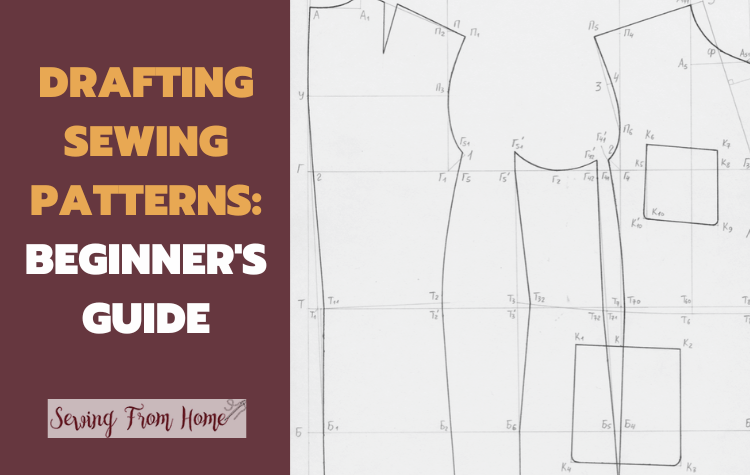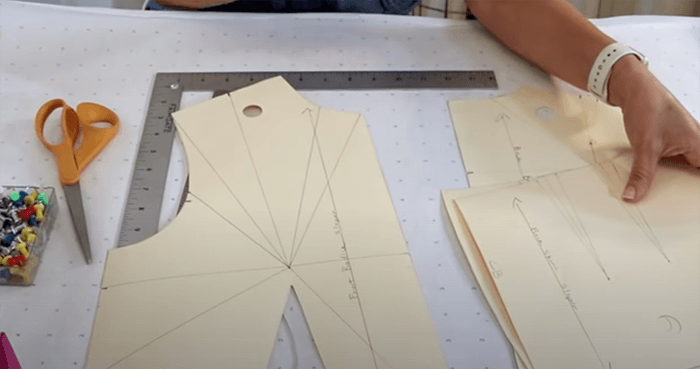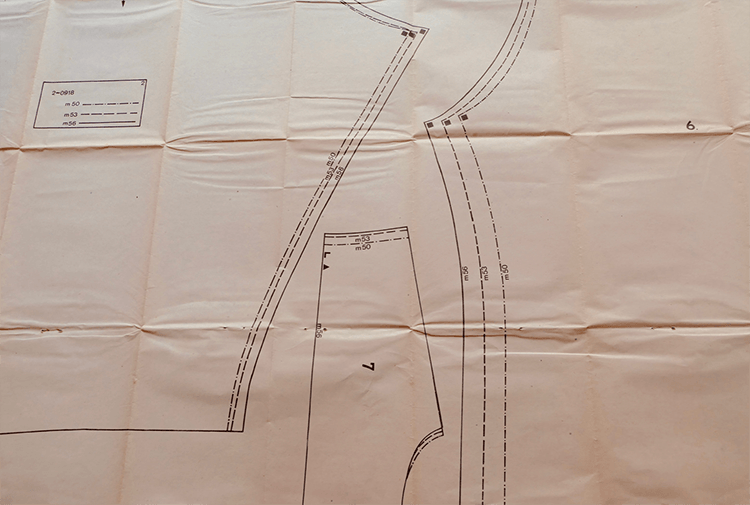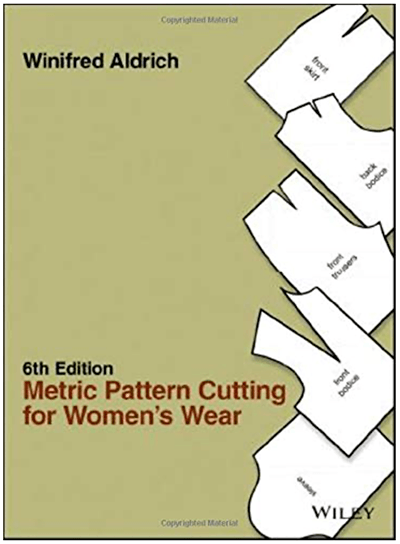While store-bought sewing patterns are great for many clothes designs, having a collection of your own drafted patterns in your size is perfect.
However, the idea might seem daunting if you have never drafted your sewing patterns. So, how do you draft sewing patterns as a beginner?
Most sewists would agree that the best place to start drafting patterns is with staples. Draft a pattern for a shirt, dress, and pants. You can then adjust these patterns to make different designs and clothes. You don’t need fancy equipment to start drafting sewing patterns.
Having an arsenal of sewing patterns with your exact measurements is the perfect way to start building your repertoire as a designer and experimenting more with designs and patterns.
To help you draft your first pattern, we’ve created this beginner’s guide for drafting sewing patterns.
- Why Should You Start Drafting Sewing Patterns
- 1. Start By Creating Some Sloper Drafts
- 2. Take Your Measurements Carefully
- 3. Consider Seam Allowances And Pattern Ease
- 4. What Tools Do You Need For Pattern Drafting?
- 5. Learn How To Grade A Pattern
- 6. Make A Test Garment
- 7. Invest In Pattern-Making Books
- 8. Use Well-Fitting Garments As A Guide
- 9. Be Patient When Starting To Draft Patterns
Why Should You Start Drafting Sewing Patterns

Until now, you might have been content using store-bought patterns (or online sewing patterns) and altering them to your size and preference.
However, as your sewing skills grow, you’ll likely want to experiment more with your designs, colors, and techniques.
This signals that it’s now time to start building a library of your own, customized sewing patterns.
Drafting patterns made specifically according to your measurements is an excellent method to help you make staples quicker. In addition, you can build on your staple drafted patterns to create more unique pieces.
So, where do you start when you want to draft sewing patterns specially made for you? We have consulted with expert sewists and designers to determine their beginner tips for drafting sewing patterns.
Here are 9 tips when drafting your own sewing patterns as a beginner.
1. Start By Creating Some Sloper Drafts
Sloper drafts are staple items created with your measurements. These drafts are essential for drafting your own sewing patterns because they form the base of many items. For example, you can also use a sloper skirt pattern for the bottom of a dress, coat, or jacket.

Sloper patterns are ideal for practicing. Because you draft them according to your measurements, you don’t have to spend time altering the sizes and measurements to fit you.
Therefore, creating some sloper drafts should be your first task when you start sewing pattern drafting.
2. Take Your Measurements Carefully
To ensure your sloper patterns and other designs are made to fit your body, take your time when measuring your body and ensure you do it correctly.
Having your correct body measurements will help a great deal when you need to draft a new pattern. In addition, having accurate body measurements for the sloper patterns will avoid unnecessary alterations.
Ensure you measure every part of your body to determine the exact size of the pattern when you need to draft it.
In addition, consider measuring the length of a short, midi, and maxi skirt, so you already have those measurements when you want to make a dress, skirt, or pants.
3. Consider Seam Allowances And Pattern Ease
It’s easy to forget about seam allowances and pattern ease when you first start drafting your patterns.
However, when you don’t account for pattern ease or seam allowances, you’ll end up with a too-small draft or make dressing and undressing inconvenient.
Seam allowances are an extra bit of fabric where your seams will be on the final product. Therefore, ensure you add extra for the seams when taking your measurements. You can always cut off more fabric if you don’t need as much seam allowance.
However, having too little fabric results in wasted time and materials.
Pattern Ease refers to the ease one has when dressing and undressing.
Everyone’s tried on a dress or shirt and found that although it sits beautifully, it’s a nightmare to get in and out of.
Consider what parts of your garment might make getting it on and off more complicated, and then determine how you will fix this.
Will you add a zipper or buttons? In this case, you should add more fabric in this area.
4. What Tools Do You Need For Pattern Drafting?

Although some brilliant and fun pattern drafting software options are available, these aren’t necessary when you first begin drafting patterns. They are expensive.
In addition, knowing how to draw a pattern manually is a crucial skill any sewist needs. Therefore, when you start drafting patterns, you only need a few basic things.
- Pattern paper to draw the pattern on.
- Pens and pencils for drawing patterns and taking measurements.
- A tape measure to measure your body and the patterns.
- Scissors. Good quality fabric scissors are essential. You can use any scissors to cut the patterns out of the paper.
- A dress form to test your patterns and make mock-ups of your patterns.
- Existing patterns for inspiration and guidance.
- Rulers. Quilting and curved dressmaking rulers will help make your pattern drafting task much more manageable and allow you to draw seams and curves accurately.
These are the essential tools you will need to start drafting sewing patterns.
However, as your pattern drafting journey progresses, you will likely add and remove some of the tools on this list as it suits you.
5. Learn How To Grade A Pattern
Grading a pattern means taking a pattern of a specific size and making it one size bigger or smaller.
This is a crucial skill when sewing and drafting your patterns. As you know, your weight and body fluctuate pretty often, and you might need to adjust your sloper patterns on occasion temporarily.
Therefore, knowing how to grade a pattern and make it a size bigger or smaller is extremely useful in sewing and when drafting new patterns based on your sloper patterns.
In addition, learning skills such as shifting seams and cutting and spreading will save you a lot of headaches down the line.
6. Make A Test Garment
When you have your pattern drafted onto the pattern paper and feel ready to start sewing, make a mock-garment first to see if the pattern works and requires any alterations.
Also, do a mock-up of your sloper garments to ensure they are, in fact, the correct size.
When making a mock-up, inspect the garment thoroughly on the dress form to see if it will work on the final product. Consider pattern ease, comfort, and looks when reviewing the mock-up. Do you need to add any seams? Are the sleeves a comfortable length?
Will the bodice cut you at the correct height?
These are all things to consider when making the mock-up. Take notes of any alterations you create and add these alterations to your pattern. Also, consider the material you will use for the final product and ask yourself if this design will work with that material.
7. Invest In Pattern-Making Books
You can learn a lot from video tutorials and sewing blogs.
However, a sewing pattern book explains the finer details of pattern drafting in more detail than any other source. In addition, there are ample pattern-making books available, and they often contain many valuable tips for pattern-making.

Many of these books also have pictures demonstrating the instructions. Pictures help when you are stuck because they visually show you what to do. There are so many excellent pattern drafting books to choose from.
Some of the books recommended by experienced sewists are:
- Metric Pattern Cutting For Women’s Wear
- Metric Pattern Cutting For Menswear
- Pattern Making With Stretch Knit Fabrics
These books are a great stepping stone when you first start pattern drafting. However, as your skills as a sewist evolve, you’re likely to add more books to your collection.
So take notes on the helpful pattern drafting tips in these books and tailor them to your needs.
8. Use Well-Fitting Garments As A Guide
In addition to using store-bought patterns as a guide for pattern drafting, you should also consider using clothes from your cupboard.
Look for some staple items in your closet you find the most comfortable and see what factors make that garment so comfortable.
Seeing what clothes you like wearing most will also help when you alter your drafted patterns. For example, see where your current pattern could benefit from pattern ease techniques. You can also use your most comfortable staple items as a size guide when drafting patterns.
Using garments from your closet is a great way to get a feel for your style and how those garments are made and fit together. This will help you determine the patterns you should draft for your sloper pattern collection.
You can also look to your closet to see how you can improve on the garments you own when drafting sewing patterns in the future.
9. Be Patient When Starting To Draft Patterns
Finally, remember that when you first start pattern drafting, you might not get it right the first time. However, don’t give up and see every failed attempt as an opportunity to learn. With the other tips we’ve mentioned, you should have a successful first pattern drafted in no time.
Your patterns won’t all be successful and may not look like anyone else’s.
However, this isn’t bad because your patterns are unique and specially designed for you.
Therefore, don’t compare your pattern drafts with anyone else’s. Instead, try to learn from others and be patient when you first start pattern drafting.
